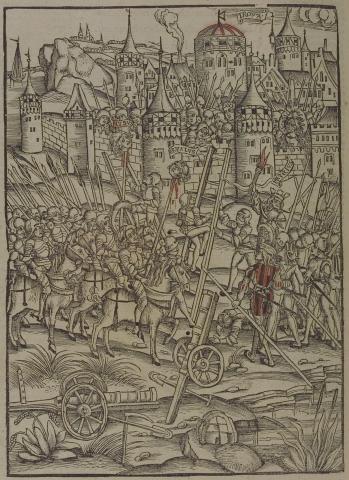Annotations
In the foreground, the Rutulians have affixed the heads of Nisus and Euryalus to pikes and hold them up within view of the Trojans on the ramparts of their fortress (465-72). On the rampart furthest to the right stands the mother of Euryalus, stricken with grief at the sight of his head (473-80). She lifts her hands to the heavens in prayer to the gods (480-97). Men try to climb the walls to the city using ladders (507); Vergil says these men are the Volsci, led by Camilla (Williams, note 505), but all commanders in the image appear to be male. The Teucrians on the wall above hold rocks to throw on the men climbing (512-4). Below the city walls, the Rutulians hold spears which they will throw at the Teucrians standing on the walls of the city (518-20). On the right, Mezentius holds a torch (521-2). Cannons and shovels, used to break down the walls of the city, lie at the bottom of the image.
Woodcut illustration from the “Strasbourg Vergil,” edited by Sebastian Brant: Publii Virgilii Maronis Opera cum quinque vulgatis commentariis expolitissimisque figuris atque imaginibus nuper per Sebastianum Brant superadditis (Strasbourg: Johannis Grieninger, 1502), fol. 339v, executed by an anonymous engraver under the direction of Brant.


Sebastian Brant (1458-1521) was a humanist scholar of many competencies. Trained in classics and law at the University of Basel, Brant later lectured in jurisprudence there and practiced law in his native city of Strasbourg. While his satirical poem Das Narrenschiff won him considerable standing as a writer, his role in the transmission of Virgil to the Renaissance was at least as important. In 1502 he and Strasbourg printer Johannes Grüninger produced a major edition of Virgil’s works, along with Donatus’ Life and the commentaries of Servius, Landino, and Calderini, with more than two hundred woodcut illustrations. (Annabel Patterson)